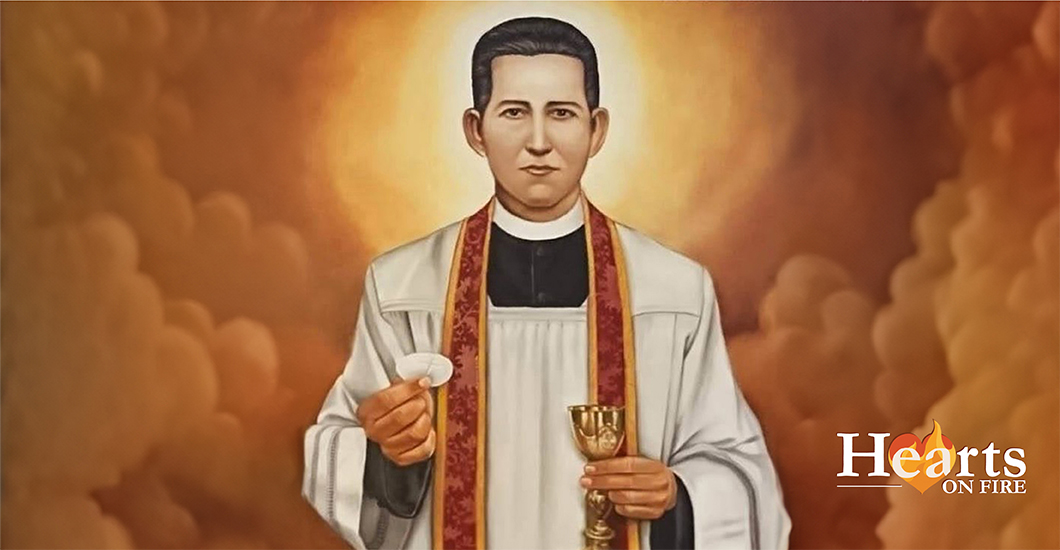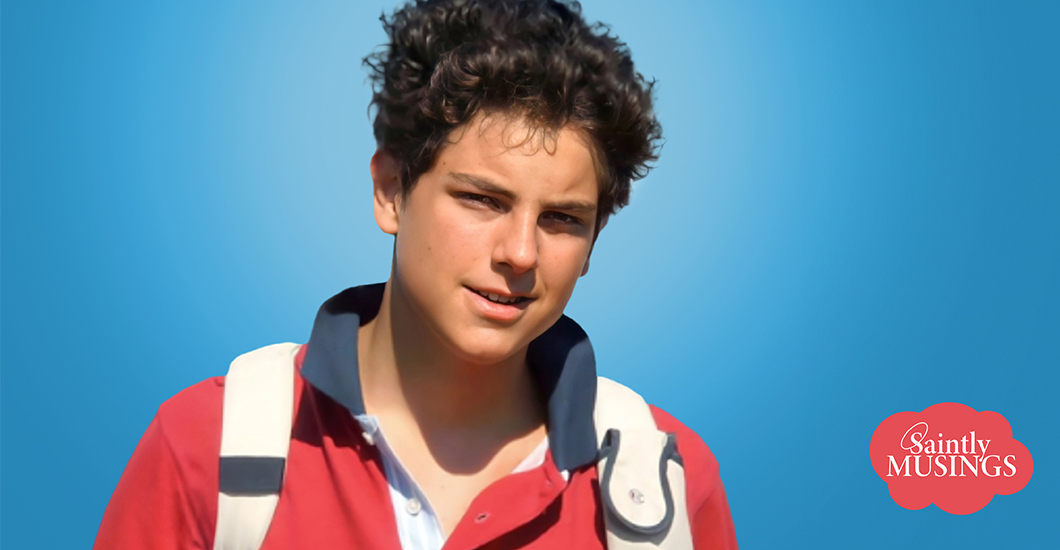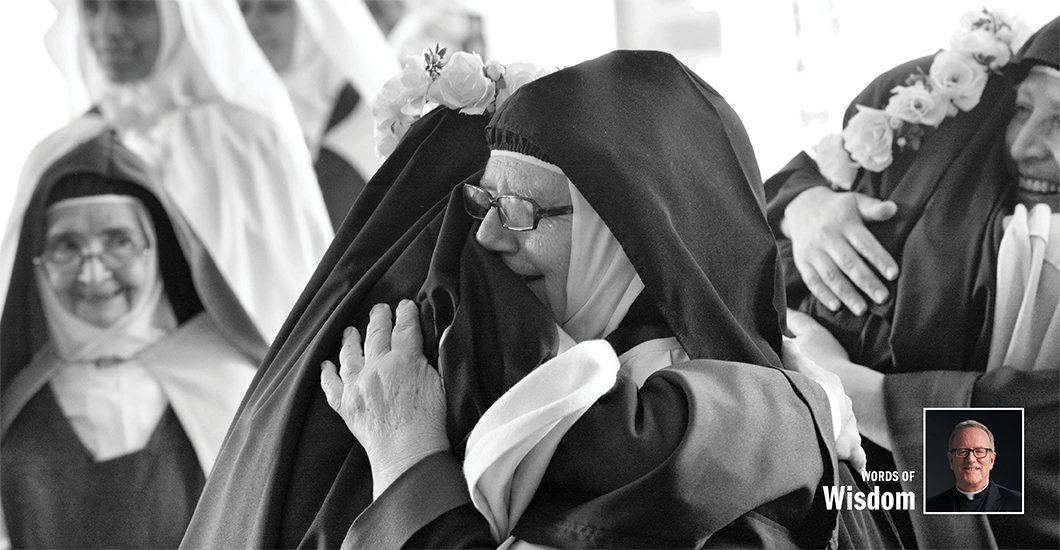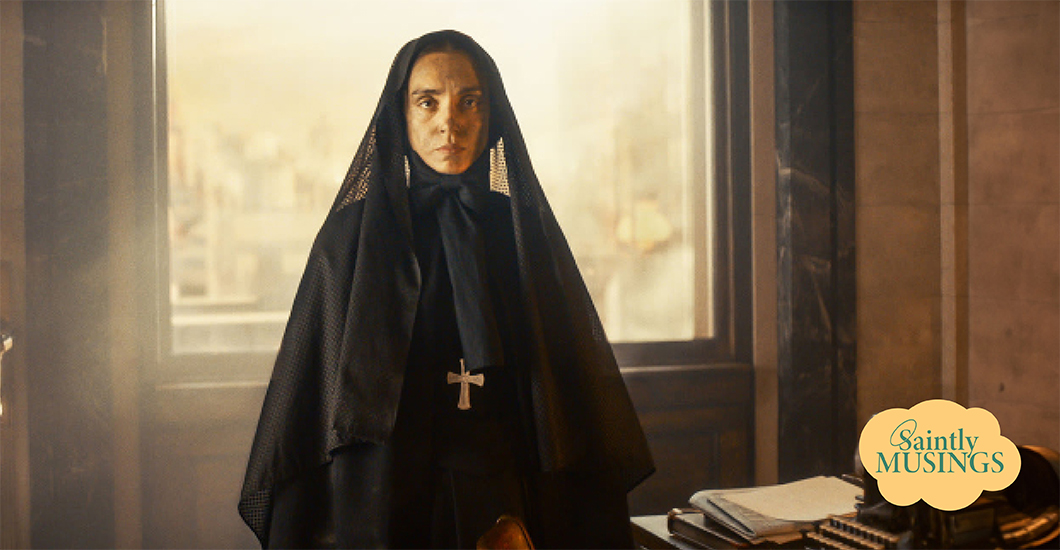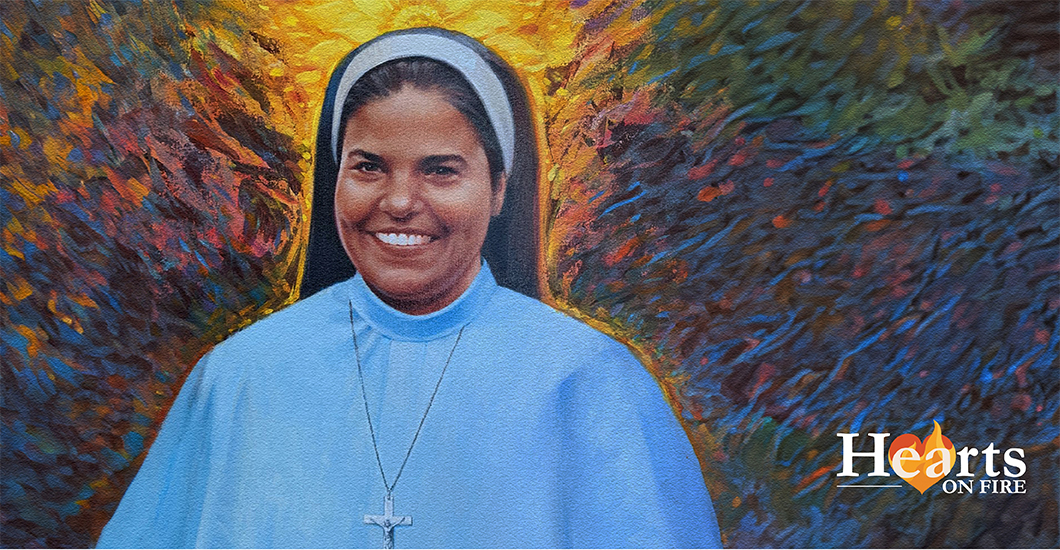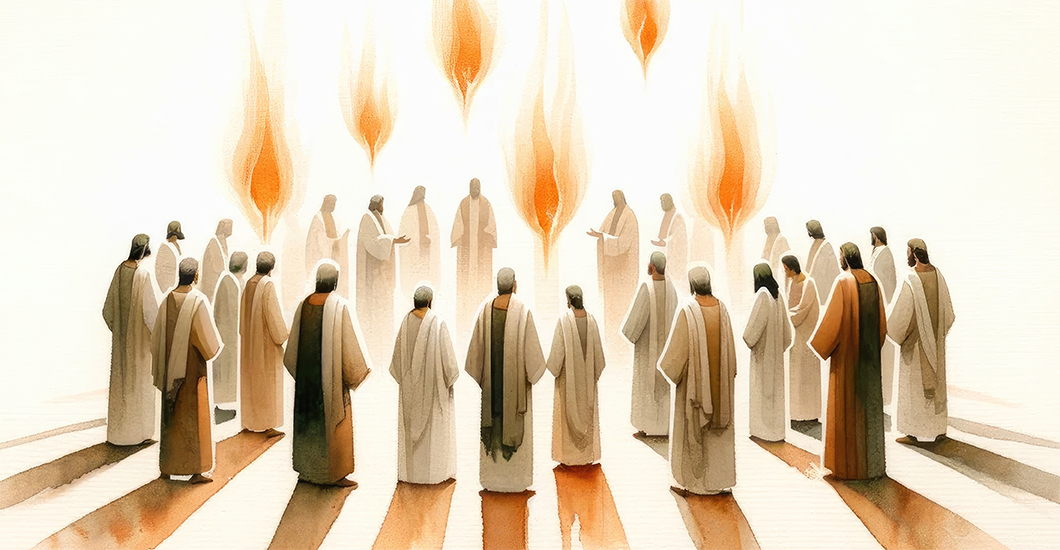Home/Evangelize/Article
Trending Articles
Lights, Camera— Convent!
Despite being a cradle Catholic, I never considered becoming a sister—that is, until the rat race got to me. Frankly, God was not my biggest priority while I climbed the corporate ladder. After graduating with a Bachelor’s degree in history and journalism, I was blinded by the allure of a glamorous, fast-paced life in network television in New York City, and I chased after a career in broadcast media. For three years I worked in areas ranging from production to research to multimedia news. I moved from job to job, working overnight and weekend shifts, holidays, doing whatever I needed to do to get ahead. As a result, my health and relationships suffered.
Yet, God was still good to me. He gave me the grace to persevere through the difficult times and, eventually, my work conditions got better. I was able to spend more time with my family and friends and serve at my parish as a catechist. And that is when I identified a yearning in my heart for something more, something better. I was still a long way from sisterhood, however.
ENCOUNTER WITH A SAINT
Growing up, I had little contact with sisters. My family belonged to a Korean Catholic parish in northern New Jersey, where I attended public schools. Two Korean sisters served in our parish, and they spoke little to no English. Although I saw them around church, I could not relate to them and did not get to know them well. Nevertheless, the sisters from my childhood must have left an impression on me because when I started getting involved with campus ministry in college, I noted the absence of sisters at our Catholic center and on retreats; I wished there were some there.
It was not a religious sister but my biological sister, Rosa, who inadvertently piqued my interest in religious life. While I was still working as a journalist, Rosainvited me to venerate the relic of Saint John Bosco when it was at Saint Patrick’s Cathedral in New York City as part of a U.S. tour. This was my first encounter with the saint who was a friend of the young and the poor and who had founded the men’s religious congregation the Salesians of Don Bosco, as well as cofounded the women’s religious congregation the Daughters of Mary Help of Christians, also known as the Salesian Sisters of Saint John Bosco. After patiently waiting my turn in line among thousands of pilgrims, I had my first encounter with Saint Don Bosco through his relic. As I touched the glass box that encased a life-size wax replica of his body, I prayed for guidance. Little did I know that a few years from then I would be entering religious life in the congregation he founded.
THE SEED OF VOCATION OF GROWS
My vocation discernment did not happen in a nice, orderly, logical fashion. I do not know if anyone discerns that way. God worked in mysterious ways over the course of three years, speaking to me through various people, events, places, and dreams. I was terrified at first that God might be calling me to be a sister! I had no idea what the vows of poverty, chastity, and obedience were all about. I did not want to give up the life I was living, despite the misgivings I was starting to have about it. Like most people, I had always dreamed of someday getting married and starting my own family, but the Lord gave me the grace to have courage and remain open. I thought it was my career that was causing this growing unrest within me. I prayerfully considered a career change and decided to leave journalism for a field where I saw greater potential to effect positive social change. With a desire to help communities through the built environment, I got a Master’s degree in urban planning. It still had not dawned on me that the hole in my heart could be filled by a religious vocation.
Halfway through graduate school, I attended a “Life in the Spirit Seminar” hosted by a charismatic young adults group. During the “Baptism in the Holy Spirit” program of the retreat, I was touched by the Holy Spirit in a very powerful way. I felt the fire of God’s love burning in my heart and on my tongue. I felt my heart filling with great joy and peace. That seminar cultivated the seed of my vocation. I began to hear God’s call to live exclusively for Him.
INSPIRED BY RELIGIOUS IN HAITI
The call grew louder while I was on a church service trip to Haiti, one of the poorest countries in the world, which had suffered a devastating earthquake in 2010. For one week, we stayed and served at a nursing home facility for the homeless elderly of Croix-des-Bouquets, about a thirty-minute drive from the nation’s capital, Port-au-Prince. The facility was staffed and operated by consecrated religious men and women of the Korean congregation known as the Kkottongnae Brothers and Sisters of Jesus. These missionary brothers and sisters, most of whom were in their thirties and forties, were trained medical professionals who lived at the facility and took great care of the residents. I was fascinated by their life. They were some of the happiest, most authentic people I had ever met. Their life of love and sacrifice for others inspired me and challenged the way I saw the world around me.
One night during a charismatic prayer meeting with the sisters and brothers of Kkottongnae, God said to me through one of the brothers there, “Go where my Light is.” When I heard these words spoken aloud, I began to sob uncontrollably because deep down in my heart I knew what that meant. God was calling me—now more clearly than ever—to follow Him in a radical way. I welcomed His invitation into my heart that night and I finally felt free.
FINDING THE RIGHT FIT
Upon my return from Haiti, with the help of a spiritual director I began to visit communities closer to home. I looked at the spirituality of each congregation more than its core work, and I asked myself if I could honestly see myself living the community’s charism and lifestyle.
As I continued to pray and discern, God led me to the Salesian Sisters a month before my graduation. These sisters were gentle, joyful, and a whole lot of fun. They offered me friendship and cordiality, without pressuring me to visit them or enter the community, allowing me to decide for myself if and when I wanted to enter.
During this time, my parents were very apprehensive about my desire to pursue religious life, with my father concerned that I was trying to escape the world and avoid responsibility for my expensive decision to go to graduate school. Many arguments ensued. He started to warm up to my decision after graduation when he saw how hard I was working—at multiple part-time jobs—to pay off my student loans. Additionally, God sent people to my dad to advocate for my vocation. Once he approved, it did not take long to win over my mom.
God continued to send me little signs to reassure me that I was on the right path even during my application process to be accepted into the Salesian Sisters. When I retrieved my baptismal record from the church where I was baptized as a baby in Seoul, Korea, I learned that the date of my Baptism was January 31, the feast day of Saint John Bosco, one of our founders. I also learned that Saint Francis De Sales, the saint I had chosen for my Confirmation, was the patron saint of the Salesians and the source of its name.
HOPEFUL FOR THE FUTURE
Now I am in my third year of formation with the Salesian Sisters—that is, preparation for full membership. I feel more fully alive now than ever before. Living the virtues of poverty, obedience and chastity enables me to be totally free to love and serve others. Though my vocation journey is not without fear, doubt, or difficulty, I have faith that God’s plan for me is, in the words of the prophet Jeremiah, “a future full of hope.”
Sister Boram Lee is a first-year novice with the Salesian Sisters of Saint John Bosco, in her third year of religious formation. She lives in Newton, New Jersey, where she helps provide sacramental retreats at Sacred Heart Center, serves as a catechist in a local parish, and attends Assumption College for Sisters. Reprinted with permission from VISION Vocation Guide, vocationnetwork.org
Related Articles
The greatest evangelist is, of course, Jesus himself, and there is no better presentation of Jesus’ evangelical technique than Luke’s masterful narrative concerning the disciples on the road to Emmaus. The story opens with two people going the wrong way. In Luke’s Gospel, Jerusalem is the spiritual center of gravity— it is the locale of the Last Supper, the Cross, the Resurrection and the sending of the Spirit. It is the charged place where the drama of Salvation unfolds. So in walking away from the capital city, these two erstwhile disciples of Jesus are going against the grain. Jesus joins them on their journey—though we are told that they are prevented from recognizing Him—and He asks them what they are talking about. Throughout His ministry, Jesus associated with sinners. He stood shoulder to shoulder in the muddy waters of the Jordan with those seeking forgiveness through the baptism of John; over and again, He ate and drank with disreputable types, much to the chagrin of the self-righteous; and at the end of His life, He was crucified in between two thieves. Jesus hated sin, but He liked sinners and was consistently willing to move into their world and to engage them on their terms. And this is a first great evangelical lesson. The successful evangelist does not stand aloof from the experience of sinners, passing easy judgment on them, praying for them from a distance; on the contrary, she loves them so much that she joins them and deigns to walk in their shoes and to feel the texture of their experience. Prompted by Jesus’ curious questions, one of the travelers, Cleopas by name, recounts all of the 'things' concerning Jesus of Nazareth: “He was a prophet mighty in word and deed before God and all the people; our leaders, though, put Him to death; we thought He would be the redeemer of Israel; this very morning, there were reports that He had risen from the dead.” Cleopas has all of the 'facts' straight; there is not one thing he says about Jesus that is wrong. But his sadness and his flight from Jerusalem testify that he doesn’t see the picture. I love the clever and funny cartoons in the New Yorker magazine, but occasionally, there is a cartoon I just don’t understand. I’ve taken in all of the details, I’ve seen the main characters and the objects around them, I’ve understood the caption. Yet, I don’t see why it’s funny. And then there comes a moment of illumination: though I haven’t seen any further detail, though no new piece of the puzzle has emerged, I discern the pattern that connects them together in a meaningful way. In a word, I 'get' the cartoon. Having heard Cleopas’ account, Jesus say: “Oh, how foolish you are! How slow of heart to believe all that the prophets said.” And then He opens the Scriptures to them, disclosing the great Biblical patterns that make sense of the 'things' that they have witnessed. Without revealing to them any new detail about Himself, Jesus shows them the form, the overarching design, the meaning—and through this process they begin to 'get' Him: their hearts are burning within them. This is the second great evangelical lesson. The successful evangelist uses the Scriptures in order to disclose the divine patterns and ultimately the Pattern who is made flesh in Jesus. Without these clarifying forms, human life is a hodge-podge, a blur of events, a string of meaningless happenings. The effective evangelist is a man of the Bible, for the Scripture is the means by which we 'get' Jesus Christ and, through Him, our lives. The two disciples press Him to stay with them as they draw near the town of Emmaus. Jesus sits down with them, takes bread, says the blessing, breaks it and gives it to them, and in that moment they recognize Him. Though they were, through the mediation of Scripture, beginning to see, they still did not fully grasp who He was. But in the Eucharistic moment, in the breaking of the bread, their eyes are opened. The ultimate means by which we understand Jesus Christ is not the Scripture but the Eucharist, for the Eucharist is Christ Himself, personally and actively present. The embodiment of the paschal mystery, the Eucharist, is Jesus’ love for the world unto death, His journey into godforsakenness in order to save the most desperate of sinners, His heart broken open in compassion. And this is why it is through the lens of the Eucharist that Jesus comes most fully and vividly into focus. And thus we see the third great evangelical lesson. Successful evangelists are persons of the Eucharist. They are immersed in the rhythms of the Mass; they practice Eucharistic adoration; they draw the evangelized to a participation in the body and blood of Jesus. They know that bringing sinners to Jesus Christ is never primarily a matter of personal witness, or inspiring sermonizing, or even exposure to the patterns of the Scripture. It is primarily a matter of seeing the broken heart of God through the broken bread of the Eucharist. So prospective evangelists, do what Jesus did. Walk with sinners, open the Book, break the Bread.
By: Bishop Robert Barron
MoreI remember a childhood story in which God, about to destroy Earth because of humanity's wrongdoing, looked down, saw the lilies of the field praying for mankind, and extended the end of time. It was my wife's desire to attend daily Mass that led us to the nearby Carmelite Monastery. I was immediately struck by the pervasive stillness and a sense of tranquility. Through the grilled gates, these nuns looked like God's lilies on earth. As I was introduced to their daily life, I was surprised to learn that the sisters make vestments, altar breads, and greeting cards. They even stitch their own habits, grow their own fruits and vegetables, and look after the other elderly sisters. Most of the day is spent in silence, which helps them to open up to the Lord and pray. The sisters even meet up twice a day to talk and share. The power of prayer and its impact dawned upon me. The Church has a rich tradition of prayer, through which we deeply connect with God, whether it's through attending Mass, reciting the Rosary, or simply taking a few moments to reflect on God's presence in our lives. The experience of visiting the Carmelite Monastery was truly humbling. It helped me reflect on the power of prayer and the importance of dedicating one's life to serving others, and left me with a sense of peace and renewed faith.
By: Winner Varghese
MoreThe Mexican Revolution which began in the early 1920s, led to the persecution of the Catholic community in that country. Pedro de Jesus Maldonado-Lucero was a seminarian at that time. Once he became a priest, despite the risk, he stood with his people. He tended to his flock during a terrible epidemic, founded new apostolic groups, reestablished associations, and ignited Eucharistic piety among his parishioners. Upon discovering his pastoral activities, the government deported him, but he managed to return and continue serving his flock, in hiding. One day, after hearing the confessions of the faithful, a gang of armed men busted his hiding place. Father Maldonado managed to grab a reliquary with Consecrated Hosts as they forced him out. The men forced him to walk barefoot throughout the town, as a crowd of the faithful followed him. The city mayor grabbed Father Maldonado's hair and dragged him toward the city hall. He was knocked to the ground, resulting in a skull fracture that popped out his left eye. He had managed to keep his grip on the pyx until this time, but now it fell out of his hands. One of the thugs took some Holy Hosts, and as he forcefully stuffed the hosts inside the priest’s mouth, he shouted: “Eat this and see if He can save you now.” Little did the soldier know that just the night before, during the Holy Hour, Father Maldonado had prayed that he would happily give his life for an end to the persecution ‘if only he would be allowed to take Communion before his death.’ The thugs left him for dead in a pool of his own blood. Some local women found him still breathing and rushed him to a nearby hospital. Father Pedro Maldonado was born into eternal life the next day, on the 19th anniversary of his priestly ordination. Pope John Paul II canonized this Mexican priest in 2000.
By: Shalom Tidings
MoreWhen Andrea Acutis arranged a pilgrimage to Jerusalem, he thought that his son would be excited. Carlo was keen on going to daily Mass and reciting his prayers, so his reply came as a surprise: "I prefer to stay in Milan … Since Jesus remains with us always, in the Consecrated Host, what need is there to make a pilgrimage to Jerusalem to visit the places where He lived 2000 years ago? Instead, tabernacles ought to be visited with the same devotion!" Andrea was struck by this great devotion that his son cherished for the Eucharist. Carlo was born in 1991, the year the World Wide Web was invented. The little genius walked when he was just four months old, and started reading and writing at the age of three. The world would’ve looked at his intellect and dreamt of a bright future but the Divine had different plans. Combining his love for the Eucharist and technology, he left the world a great legacy of a record of Eucharistic miracles from across the world. He began the collection in 2002 when he was just 11 years old and completed it a year before he succumbed to leukemia. This young computer geek, at such a young age, even built a website (carloacutis.com), a lasting record, with all the collected information. The Eucharistic exhibition he pioneered was held in five continents. Ever since, many miracles have been reported. On his website, he has written the lasting mission of his life on Earth: "The more Eucharist we receive, the more we will become like Jesus, so that on this Earth, we will have a foretaste of Heaven." This Italian teenage designer and computer whiz is soon to become Saint Carlo Acutis. Widely known as the first millennial patron of the internet, Blessed Carlo continues to draw millions of youngsters to the love of Jesus in the Eucharist.
By: Shalom Tidings
MoreWhen she lost her mobility, eyesight, listening, voice, and even the sense of touch, what prompted this young girl to describe her life as ‘sweet?’ Little Benedetta, at age seven, wrote in her diary: “The universe is enchanting! It is great to be alive.” This intelligent and happy lass, unfortunately, contracted polio in her childhood, which left her body crippled, but nothing could cripple her spirit! Hard Times on Roll Benedetta Bianchi Porro was born in Forlì, Italy, in 1936. As a teenager, she began to go deaf, but despite this, she entered medical school, where she excelled, taking oral exams by reading the lips of her professors. She had an ardent desire to become a missionary doctor, but after five years of medical training and just one year short of completing her degree, she was forced to end her studies due to increasing illness. Benedetta diagnosed herself with neurofibromatosis. There are several iterations of this cruel disease, and in Benedetta’s case, it attacked the nerve centers of her body, forming tumors on them and gradually causing total deafness, blindness, and later, paralysis. As Benedetta’s world shrank, she demonstrated extraordinary courage and holiness and was visited by many who sought her counsel and intercession. She was able to communicate when her mother would sign the Italian alphabet into her left palm, one of the few areas of her body that remained functional. Her mother would sign letters, messages, and Scripture painstakingly into Benedetta’s palm, and Benedetta would reply verbally despite her voice having been weakened to a whisper. “They’d come and go in groups of ten and fifteen,” said Maria Grazia, one of Benedetta’s closest confidantes. “With her mother as interpreter, she was able to communicate with each one. It seemed as though she could read our innermost souls with extreme clarity, even though she couldn’t hear or see us. I will always remember her with her hand extended ready to receive the Word of God and her brothers and sisters.” (Beyond Silence, Life Diary Letters of Benedetta Bianchi Porro) It’s not that Benedetta never experienced agony or even anger at this disease that was robbing her of the ability to become a medical doctor, but in accepting it, she became a doctor of another sort, a kind of surgeon to the soul. She was, indeed, a spiritual doctor. In the end, Benedetta was no less a healer than she ever desired to be. Her life had shrunken all the way down to the palm of her hand, it was no bigger than a Communion host—and yet, just like a Blessed Communion Host, it had become more powerful than she would have ever imagined. It is impossible to miss the correlation between Benedetta’s life and Jesus in the Blessed Sacrament who is hidden and small too, silent and even weak, but an ever-present friend to us. Towards the end of her life, she wrote to a young man who suffered similarly: “Because I'm deaf and blind, things have become complicated for me … Nevertheless, in my Calvary, I do not lack hope. I know that at the end of the road, Jesus is waiting for me. First in my armchair, and now in my bed where I now stay, I have found wisdom greater than that of men—I have discovered that God exists, that He is love, faithfulness, joy, certitude, to the end of the ages … My days are not easy. They are hard. But sweet because Jesus is with me, with my sufferings, and He gives me His sweetness in my loneliness and light in the darkness. He smiles at me and accepts my collaboration.” (Venerable Benedetta Biancho Porro, by Dom Antoine Marie, OSB) A Compelling Reminder Benedetta passed away on January 23, 1964. She was 27 years old. She was venerated on December 23, 1993, by Pope John Paul II and beatified on September 14, 2019, by Pope Francis. One of the great gifts that the Saints bring to the Church is that they give us a clear picture of what virtue looks like, even in incredibly difficult circumstances. We need to ‘see ourselves’ in the lives of the Saints in order to be strengthened for our own. Blessed Benedetta is truly a model of sanctity for our times. She is a compelling reminder that even a life filled with serious limitations can be a powerful catalyst for hope and conversion in the world and that the Lord knows and fulfills the deepest desire of every heart, often in surprising ways. A Prayer to Blessed Benedetta Blessed Benedetta, your world became as small as a communion wafer. You were immobilized, deaf, and blind, and yet you were a powerful witness to the love of God and the Blessed Mother. Jesus in the Blessed Sacrament is hidden and small too, silent, immobilized, and even weak—and still all-powerful, ever present to us. Please pray for me, Benedetta, that I will collaborate, as you did, with Jesus, in whatever way He wishes to use me. May I be granted the grace to allow the Almighty Father to speak through my littleness and loneliness, too, for the glory of God and the salvation of souls. Amen.
By: Liz Kelly Stanchina
MoreQ - My many Christian friends celebrate ‘Communion’ every Sunday, and they argue that the Eucharistic presence of Christ is only spiritual. I believe Christ is present in the Eucharist, but is there any way to explain it to them? A – It is indeed an incredible claim to say that at every Mass, a small piece of bread and a small chalice of wine become the very flesh and blood of God Himself. It is not a sign or a symbol, but truly the body, blood, soul, and divinity of Jesus. How can we make this claim? There are three reasons why we believe this. First, Jesus Christ said so Himself. In John’s Gospel, Chapter 6, Jesus says: “Amen, amen, I say to you, unless you eat the flesh of the Son of Man and drink His blood, you do not have life within you. Whoever eats My flesh and drinks My blood has eternal life, and I will raise him on the last day. For My flesh is true food, and My blood is true drink. Whoever eats My flesh and drinks My blood remains in Me and I in him.” Whenever Jesus says, “Amen, Amen, I say to you…”, this is a sign that what He is about to say is completely literal. Further, Jesus uses the Greek word trogon which is translated ‘to eat’—but really means ‘to chew, gnaw, or rip with one’s teeth.’ It’s a very graphic verb which can only be used literally. Also, consider the reaction of His hearers; they walked away! It says in John 6: “as a result of this [teaching], many of His disciples returned to their former way of life and no longer accompanied Him.” Does Jesus chase them down, tell them that they misunderstood Him? No, He allows them to leave—because He was serious about this teaching that the Eucharist is truly His flesh and blood! Second, we believe because the Church has always taught it from its earliest days. I once asked a priest why there was no mention of the Eucharist in the Creed which we profess every Sunday—and he replied that it was because no one debated His Real Presence, so it wasn’t necessary to officially define it! Many of the Church Fathers wrote about the Eucharist—for example, Saint Justin Martyr, writing around the year 150 AD, penned these words: “For not as common bread and common drink do we receive these; but we have been taught that the food which is blessed by the prayer of His word, and from which our blood and flesh are nourished, is the flesh and blood of that Jesus who was made flesh.” Every Church Father is in agreement—the Eucharist is truly His flesh and blood. Finally, our faith is strengthened through the many Eucharistic miracles in the history of the Church—over 150 officially documented miracles. Perhaps the most famous occurred in Lanciano, Italy in the 800s, where a priest who doubted Christ’s presence was shocked to find that the Host became visible flesh, while the wine became visible as blood. Later scientific tests discovered that the Host was heart flesh from a human male, type AB blood (very common among Jewish men). The heart flesh had been badly beaten and bruised. The blood had congealed into five clumps, symbolizing the five wounds of Christ, and miraculously the weight of one of the clumps is equal to the weight of all five taken together! Scientists cannot explain how this flesh and blood has lasted for twelve hundred years, which is an inexplicable miracle in itself. But how can we explain how this happens? We make a distinction between accidents (what something looks like, smells like, tastes like, etc) and substance (what something actually is). When I was a young child, I was at my friend’s house, and when she left the room, I saw a cookie sitting on a plate. It looked delectable, smelled like vanilla, and so I took a bite…and it was soap! I was so disappointed, but it taught me that my senses could not always decipher what something actually is. In the Eucharist, the substance of bread and wine change into the substance of Christ’s body and blood (a process known as transubstantiation), while the accidents (the taste, smell, look) remain the same. It does indeed take faith to recognize that Jesus is truly present, since it cannot be perceived by our senses, nor is it something we can deduce with our logic and reason. But if Jesus Christ is God and He cannot lie, I am willing to believe that He is not a sign or symbol, but truly present in the Most Blessed Sacrament!
By: Father Joseph Gill
MoreMy new hero is Mother Alfred Moes. I realize that she is not a household name, even among Catholics, but she should be. She came on my radar screen only after I became the Bishop of the Diocese of Winona-Rochester, where Mother Alfred did most of her work and where she lies buried. Hers is a story of remarkable courage, faith, perseverance, and sheer moxie. Trust me, once you take in the details of her adventures, you will be put in mind of a number of other gritty Catholic Mothers: Cabrini, Teresa, Drexel, and Angelica, to name a few. Mother Alfred was born Maria Catherine Moes in Luxembourg in 1828. As a young girl, she became fascinated by the possibility of doing missionary work among the native peoples of North America. Accordingly, she journeyed with her sister to the New World in 1851. First, she joined the School Sisters of Notre Dame in Milwaukee but then transferred to the Holy Cross Sisters in La Porte, Indiana, a group associated with Father Sorin, CSC, the founder of the University of Notre Dame. After clashing with her superiors—a rather typical happenstance for this very feisty and confident lady—she made her way to Joliet, Illinois, where she became superior of a new congregation of Franciscan sisters, taking the name ‘Mother Alfred.’ When Bishop Foley of Chicago tried to interfere with the finances and building projects of her community, she set out for greener pastures in Minnesota, where the great Archbishop Ireland took her in and allowed her to establish a school in Rochester. It was in that tiny town in southern Minnesota that God commenced to work powerfully through her. In 1883, a terrible tornado tore through Rochester, killing many and leaving many others homeless and destitute. A local doctor, William Worrall Mayo, undertook the task of caring for the victims of the disaster. Overwhelmed by the number of injured, he called upon Mother Alfred’s sisters to help him. Though they were teachers rather than nurses and had no formal training in medicine, they accepted the mission. In the wake of the debacle, Mother calmly informed Doctor Mayo that she had a vision that a hospital should be built in Rochester, not simply to serve that local community, but rather the whole world. Astonished by this utterly unrealistic proposal, Doctor Mayo told Mother that she would need to raise $40,000 (an astronomical figure for that time and place) in order to build such a facility. She in turn told the doctor that if she managed to raise the funds and build the hospital, she expected him and his two physician sons to staff the place. Within a short span of time, she procured the money, and the Saint Mary’s Hospital was established. As I’m sure you’ve already surmised, this was the seed from which the mighty Mayo Clinic would grow, a hospital system that indeed, as Mother Alfred envisioned long ago, serves the entire world. This intrepid nun continued her work as builder, organizer, and administrator, not only of the hospital that she had founded, but of a number of other institutions in southern Minnesota until her death in 1899 at the age of seventy-one. Just a few weeks ago, I wrote about the pressing need in our diocese for priests, and I urged everyone to become part of a mission to increase vocations to the priesthood. With Mother Alfred in mind, might I take the occasion now to call for more vocations to women’s religious life? Somehow the last three generations of women have tended to see religious life as unworthy of their consideration. The number of nuns has plummeted since the Second Vatican Council, and most Catholics, when asked about this, would probably say that being a religious sister is just not a viable prospect in our feminist age. Nonsense! Mother Alfred left her home as a very young woman, crossed the ocean to a foreign land, became a religious, followed her instincts and sense of mission, even when this brought her into conflict with powerful superiors, including a number of Bishops, inspired Doctor Mayo to establish the most impressive medical center on the planet, and presided over the development of an order of sisters who went on to build and staff numerous institutions of healing and teaching. She was a woman of extraordinary intelligence, drive, passion, courage, and inventiveness. If someone had suggested to her that she was living a life unworthy of her gifts or beneath her dignity, I imagine she would have a few choice words in response. You’re looking for a feminist hero? You can keep Gloria Steinem; I’ll take Mother Alfred any day of the week. So, if you know a young woman who would make a good religious, who is marked by smarts, energy, creativity, and get-up-and-go, share with her the story of Mother Alfred Moes. And tell her that she might aspire to that same kind of heroism.
By: Bishop Robert Barron
MoreIn the early 1900s, Pope Leo XIII requested the congregation of Missionary Sisters of the Sacred Heart to go to the United States to minister to the significant number of Italian immigrants there. The congregation’s founder, Mother Cabrini, desired to do a mission in China, but obediently heeded the Church’s call and embarked on a long journey across the sea. As she had nearly drowned as a child, she formed a great fear of water. Still, in obedience, she...across the sea. On arrival, she and her sisters found that their financial aid had not been sanctioned, and they had no place to live. These faithful daughters of the Sacred Heart persevered and began serving the people on the margins. In a few years, her mission among the immigrants flourished so fruitfully that till her passing, this aquaphobic nun made 23 transatlantic trips around the world, founding educational and healthcare facilities in France, Spain, Great Britain, and South America. Her obedience and attentiveness to the Church’s missionary call was eternally rewarded. Today, the Church venerates her as the patron saint of immigrants and hospital administrators.
By: Shalom Tidings
MoreRani Maria Vattalil was born on 29 January 1954 to Eleeswa and Paily Vattalil in a small village called Pulluvazhy, in Kerala, India. From a young age, she was brought up in the Christian faith, having love for the poor. She attended daily Mass and led family prayers. During the final year of high school, Rani felt the Lord calling her to consecrated life and entered the Franciscan Clarist Congregation in 1972. It was Rani Maria’s ardent desire to do missionary work in North India and serve the poor, even if it cost her life. She was sent to Madhya Pradesh (a central Indian state) and served several mission areas there. Sister Rani Maria was given the responsibility of coordinating the social apostolate of the local diocese. She organized various educational programs for children and young people and worked relentlessly to empower the indigenous people. She understood how the poor, illiterate farmers were exploited and taken advantage of by their landlords. So, she educated them on their rights, helped them fight for justice, and spoke for those who were unjustly imprisoned. All this infuriated the upperclass landlords, who threatened her with dire consequences if she continued supporting the cause of the poor. But Rani Maria feared nothing and did not back down from her mission to 'love her neighbor.' A devious plan was then hatched by those who hated her. On 25th February 1995, while traveling by bus, she was mercilessly stabbed 54 times by Samundhar Singh—a man hired by the landlords. She breathed her last, repeating the Holy name of Jesus. Rani Maria worked her entire life to fight for the dignity and rights of her fellow men and bore witness to the Gospel through her social activities. Sister Rani Maria’s family, following the valiant example of their daughter, forgave her murderer wholeheartedly, even inviting him to their home! This act of mercy touched him deeply; he repented of his heinous crime and became a changed man. Sister Rani Maria was beatified by Pope Francis on 4th November 2017.
By: Shalom Tidings
MoreWherever you are and whatever you do, you are irrevocably called to this great mission in life. In the mid-eighties, Australian director Peter Weir made his first American film, a successful thriller, Witness, which starred Harrison Ford. The movie is about a young boy who sees the murder of an undercover police officer by corrupt co-workers, and he’s hidden away in an Amish community for protection. As the story unfolds, he recalls what happened by putting the pieces together and then, he tells the Ford character named John Book (note the Gospel symbolism). The movie contains the marks of a witness: one sees, recalls, and tells. Circling Back Jesus showed Himself to His innermost circle so that the truth of His Resurrection would reach everyone through them. He opened the minds of His disciples to the mystery of His Death and Resurrection saying: “You are witness to these things” (Luke 24:48). Having seen Him with their own eyes, the Apostles could not remain silent about this incredible experience. What’s true for the Apostles is also true for us because we are members of the Church, the mystical Body of Christ. Jesus commissioned his disciples to “Go, therefore, and make disciples of all nations, baptizing them in the name of the Father, and of the Son, and of the Holy Spirit.” (Matthew 28:19) As missionary disciples, we testify that Jesus is alive. The only way we can enthusiastically and steadfastly embrace this Mission is to see through the eyes of faith that Jesus is Risen, that He is alive, and present within and among us. That’s what a witness does. Circling back, how does one ‘see’ the Risen Christ? Jesus instructed us: “Unless a grain of wheat falls into the earth and dies, it remains alone; but if it dies, it bears much fruit.” (John 12:23-24) Put simply, if we really want to ‘see’ Jesus, if we want to know Him deeply and personally, and if we want to understand Him, we have to look to the grain of wheat that dies in the soil: in other words, we have to look to the Cross. The Sign of the Cross marks a radical shift from self-reference (Ego-drama) to being Christ-centered (Theo-drama). In itself, the Cross can only express love, service, and unreserved self-giving. It is only through sacrificial giving of the self for the praise and glory of God and the good of others that we can see Christ and enter Trinitarian Love. Only in this way can we be grafted onto the ‘Tree of Life’ and truly ‘see’ Jesus. Jesus is Life itself. And we are hard-wired to seek Life because we are made in God’s image. That’s why we’re drawn to Jesus—to ‘see’ Jesus, meet Him, know Him, and fall in love with Him. That’s the only way we can be effective witnesses to the Risen Christ. The Hidden Seed We too must respond with the witness of a life that is given in service, a life that is patterned after the Way of Jesus, which is a life of sacrificial self-giving for the good of others, recalling that the Lord came to us as servants. Practically speaking, how can we live such a radical life? Jesus told His disciples: “You will receive power when the Holy Spirit has come upon you; and you will be My witnesses.” (Acts 1:8) The Holy Spirit, just as He did at the first Pentecost, frees our hearts chained by fear. He overcomes our resistance to do our Father’s will, and He empowers us to give witness that Jesus is Risen, He is alive and He is present now and forever! How does the Holy Spirit do this? By renewing our hearts, pardoning our sins, and infusing us with the seven gifts that enable us to follow the Way of Jesus. It is only through the Cross of the hidden seed, ready to die, that we can truly ‘see’ Jesus and therefore give witness to Him. It is only through this intertwining of death and life that we can experience the joy and fruitfulness of a love that flows from the heart of the Risen Christ. It is only through the power of the Spirit that we reach the fullness of the Life He gifted us with. So, as we celebrate Pentecost, let us resolve by the gift of Faith to be witnesses of the Risen Lord and bring the Paschal gifts of joy and peace to the people we encounter. Alleluia!
By: Deacon Jim McFadden
MoreLatest Articles
Christmas comes with the reminder of getting gifts for everyone, but is it really the gift that matters? Browsing in a local Christian bookstore many years ago with my boyfriend at the time, our eyes landed on a particular picture at exactly the same moment. It was a large, colorful depiction of Jesus, entitled The Laughing Christ; with His head tossed back slightly, somewhat disheveled, dark brown hair framed crinkled eyes, twinkling with delight! It was perfectly enchanting! We found ourselves staring at the slightly crooked smile beneath the subject of the portrait's engaging gaze. Oh, so inviting! So accepting! So attractive! Glancing up from this likeness toward each other, we shared the excitement the other felt at discovering this unique presentation of the person we had each come to know and trust in the last few years. We were both raised with statues and pictures of Jesus in our respective homes, but He was always portrayed as serious, somehow detached from life as we knew it. While we believed the person represented in these images had truly lived on this earth and even prayed to Him when we needed something, our faith individually had recently become something very real...alive, even. This artist’s impression reflected who we both discovered the Lord to be in our lives—someone with whom we could share life, someone who loved us in ways we had never known before, someone who revealed Himself to us when we prayed. As a result, our understanding of God was transformed from merely an intellectual assent of His existence to a new experience of a living, communicative, and wonderful friend; our very best friend. Even as we left the store a little while later, our animated conversation about this portrayal continued. It captured each of our hearts, yet neither of us had made a move to purchase it. As soon as I got home, I knew I had to go back and buy this picture. A few days later, I did just that, then carefully wrapped it, and waited excitedly for Christmas to arrive. Gift of Honor The days passed till finally, it was Christmas Eve. With carols playing in the background, we sat on the floor near the small straggly artificial tree given to me by my mother. Handing my gift to my beloved, I waited expectantly to hear his appreciation as he spied the new wristwatch I had placed on the paw of the little stuffed dog who would cleverly deliver the timepiece. A mumbled “thanks” was all the response I got. No worries, that wasn't the gift that I knew would be perfect. But first, I was to open his gift to me. Reaching to accept it, I felt a bit puzzled. It was large, rectangular, and flat. As I began to open it, pulling the wrapping paper away from the present, I suddenly saw...my picture?! The same one I secretively purchased for him? Yes, that was it! The Laughing Christ. The picture I loved so much but instead of being thrilled, I felt disappointed. This was supposed to be his present. The one I knew was exactly what he wanted. I tried to hide my disappointment, leaning over to give him a kiss while expressing my appreciation. Then pulling out the present I had carefully wrapped and hidden behind the tree, I gave it to the object of my love. He opened it, ripping the paper quickly, revealing the contents of the package. His face looked happy...didn't it? Or was it a bit crestfallen like I had felt mine would have looked if I hadn't worked so hard to hide my disappointment from him when it had been my turn to open a gift? Oh, we both said the all right words, of course, yet somehow we sensed the gift we received from each other was not nearly as meaningful to us as we had hoped. It was the giving of that present that we both looked forward to with such anticipation. It reflected the Christ we’d both experienced and our desire was to share who we each had come to know. That was where the joy was found, not in having our own desires met, but in fulfilling the desires of the other. In time, my relationship with that young man ended. While it was painful, the joyful image of Jesus continued to hold a place of honor on my wall. Now, it is so much more than just a depiction, and so much more than just a man. It stays as a reminder of the One who would never leave me, the One with whom I would always be in a relationship, the One who would dry my tears many times through the years. But more than that, the One who is always such a source of delight in my life. After all, He was my life. Those crinkling eyes met mine. Then, that engaging smile invited me to pull the corners of my own mouth upward. And just like that, I was laughing alongside my Best Friend.
By: Karen Eberts
MoreI didn’t know their language or their emotional pain...How could I connect with them? Thursday, February 22, 2024, is a day I will never forget. At 05:15 AM, along with several of my colleagues in Catholic Social Services, I awaited the arrival of 333 refugees from Ethiopia, Eritrea, Somalia, and Uganda. Egyptian Airlines was entrusted with flying them from Entebbe, Uganda, to Cairo, Egypt, and finally to their Canadian entry point, Edmonton. Suddenly, the doors at the other end opened and the passengers started walking toward us. Not knowing how to speak their languages, I felt extremely vulnerable. How would I, as one so privileged to be born in Canada, one who has never spent a moment in a refugee camp, be able to greet these exhausted, hopeful, apprehensive sisters and brothers in a way that would say: “Welcome to your new home”...? I asked one of my colleagues who speaks five languages: “What can I say?” “Just say, Salam, that will be enough”. Suddenly, the doors at the other end opened and the passengers started walking toward us. Not knowing how to speak their languages, I felt extremely vulnerable. How would I, as one so privileged to be born in Canada, one who has never spent a moment in a refugee camp, be able to greet these exhausted, hopeful, apprehensive sisters and brothers in a way that would say: “Welcome to your new home”...? I asked one of my colleagues who speaks five languages: “What can I say?” “Just say, Salam, that will be enough”. Extending a Hand After everyone was lined up in the Customs Hall, our team went downstairs and began passing out bottles of water, granola bars, and oranges. I noticed one older Muslim woman, perhaps 50-55 years of age, bent over her trolley, trying to push it. I went and greeted her with ‘Salam’ and smiled. With gestures, I tried to ask if I could help push her trolley. She shook her head: “No.” Six hours later, outside the Customs Hall, people were sitting in different cordoned-off areas; only 85 would be remaining in Edmonton and were waiting for family or friends to meet them and take them home. Some would be boarding a bus to be taken to other cities or towns, and still others would be overnighting in a hotel and would fly to their final destination the next day. For those who were being bussed to other cities in Alberta, a four to seven-hour trip awaited them. The elderly Muslim woman I had seen in the Customs Hall, I discovered, was to fly to Calgary the next day. I looked at her and smiled, and her whole face was radiant. As I approached her, she said in faltering English: “You love me.” I took her hands in mine, looked into her eyes, and said: “Yes, I love you and God/Allah loves you.” The young woman next to her, whom I discovered was her daughter, said to me: “Thank you. Now my Mom is happy.” With tears in my eyes, a heart full of joy, and very tired feet, I left the Edmonton International Airport, profoundly grateful for one of the most beautiful experiences of my life. I may never encounter her again, but I know with absolute certainty that our God who is the embodiment of tender, compassionate love was made visible and tangible to me through my beautiful Muslim sister. In 2023, there were 36.4 million refugees seeking a new homeland and 110 million people displaced because of war, drought, climate change, and more. Day in and day out, we hear comments like: “Build walls,” “Close the borders,” and “They are stealing our jobs.” I hope that my story will, in some small way, help people understand the scene of Matthew 25 better. The righteous asked Jesus: “When Lord, God, did we do all these for you?” and He replied: “Whenever you did it to one of these little ones of Mine, you did it to Me.”
By: Sr. Mary Clare Stack
MoreCrosses came in one after the other, but the Lord’s mercy never failed this family! I gave birth to my firstborn ten years ago, and we were overjoyed! I still remember the day; we were so glad to know that it was a baby girl. I couldn’t thank the Lord enough for His blessings upon my family. Like every mother, I dreamt of buying cute frocks, clips, and booties for my little doll. We named her ‘Athalie,’ meaning ‘God is exalted.’ We were praising God for His beautiful gift. Little did we know that our joy would soon be turned into a deep heartache or that our prayer of gratitude would soon be replaced with petitions for His mercy for our precious baby. At four months old, she became severely sick. With multiple seizure attacks, she would cry for hours and couldn’t sleep or feed well. After multiple tests, she was diagnosed with brain damage; she was also suffering from a rare kind of severe childhood epilepsy named ‘West Syndrome,’ which affects one in 4,000 children. Repeated Blows The diagnosis was too shocking and heartbreaking for us. I didn’t know how I could face the storm. I wanted my heart to be numb to the emotional pain I was going through. Many questions ran through my mind. This was just the beginning of a long and painful journey that I was never prepared to take. My baby girl continued to suffer from seizures for almost two and a half years. Doctors tried multiple medicines, painful daily injections, and numerous blood tests. She would cry for hours and all I could do was to ask for God to bestow His mercy on my child. I felt helpless for not being able to comfort her in any way. Life felt like a deep and dark pit of agony and despair. Her seizures eventually subsided, but she suffered global developmental delays. As her treatment was progressing, another shocking news rattled our family. Our son Asher, who was having speech delay and behavioral issues, was diagnosed with high-functioning autism at the age of three. We were on the verge of losing hope; life felt too overwhelming for us as new parents. No one could understand or feel the pain we were going through. We felt lonely and miserable. However, this period of loneliness and the painful days of motherhood brought me closer to God; His Word provided solace to my weary soul. His promises, which I was now reading with a deeper meaning and fuller understanding, encouraged me. Spirit-led Penmanship It was during this difficult season of my life that God enabled me to write faith-filled and encouraging blogs for people going through challenges and suffering similar to mine. My articles, birthed from my daily devotions, shared the challenges of special parenthood and included my life experiences and insights. God used my words to heal many aching souls. I am truly grateful to Him for turning my life into a useful vessel for His love. I would say that the despair of our daughter’s sickness solidified our family’s faith in God. As my husband and I ventured onto the unknown path of this unique parenthood journey, all that we had to cling to were the promises of God and the faith in our hearts that God will never leave nor forsake us. What once appeared like heaps of ashes began to turn into beauty of strength as God extended His grace, peace, and joy to us during the most heart-wrenching and dark season of our life. In the loneliest moments, spending time at His feet brought us renewed hope and the courage to move ahead. Answered Prayers After years of treatment and unending prayers, Athalie’s seizures are now controlled, but she continues to have a severe form of cerebral palsy. She can’t talk, walk, see, or sit by herself and is completely dependent on me. Having recently moved from India to Canada, our family is currently receiving the best treatment. A substantial improvement in her health is making our lives more colorful. Asher is out of the spectrum, and he has caught up completely on his speech. After many schools had initially rejected him because of his inattentiveness, I home-schooled him till grade five. Though he shows a few traits of ADHD, by God’s grace, he is now enrolled in grade six in a private Christian school. He is a book lover who shows a unique interest in the solar system. He loves learning about different countries, their flags, and maps. Though life is still filled with challenges, the love of God is what makes us parent our children with love, patience, and kindness. As we continue to embrace the hope we have in Jesus and travel through this unique path of special-needs-parenting, I believe that there are times when we have answers to our prayers right away, and our faith works and produces results. In those times, God’s strength and power are revealed in what He does for us—the sure answer to our prayers. On other occasions, His strength continues to shine through us, enabling us to endure our pain with courage, letting us experience His loving mercies in our difficulties, showing us His power in our weaknesses, teaching us to develop the ability and wisdom to take the right steps ahead, empowering us to tell stories of His strength, and encouraging us to witness His light and hope amidst our challenges.
By: Elizabeth Livingston
MoreJohn Taylor was in his mid-50s when he came home one day from a game of golf and shared with his wife a strange pain he had begun to experience in his hands. He was soon diagnosed with Hodgkin’s Lymphoma, a rare form of cancer that would slowly reduce his athletic body to mere skin and bones in a span of just 20 years. As the illness grew in strength, part of his tongue was removed; he couldn’t speak or eat, so he was fed directly through a tube. Though I had trouble understanding what he was saying, I enjoyed his company very much. He had a great sense of humor, and Anne was a beautiful cook, so I ended up spending many evenings with the family. In 2011, at the height of his illness, John, who belonged to the Church of Wales, expressed his desire to become a Catholic like his wife Anne! On Christmas Eve, a Mass was held for him in their living room. At the time of Holy Communion, I poured a little jug of the Precious Blood through his tube directly into his stomach so that he could celebrate his First Holy Communion. It was one of the most extraordinary First Holy Communions I've ever seen and one of the most beautiful Christmas Eve of my life. The memory of that day and that blessed couple still reminds me of what I am doing as a priest—bringing the Incarnation and the Precious Blood of Christ to the world. During his last days, John bled profusely every morning, so Anne had to repeatedly change his bedclothes. It was extraordinary—while John’s state reminded me of the crucified Christ, Anne was configured to the Virgin Mary who stood by and took care of Him in His passion. We buried Anne last year, more than a decade after John’s passing. Jesus said the Saints would shine like stars in the Kingdom of God; now, with two more, the night sky is brighter.
By: Father Mark Byrne
More





